Review
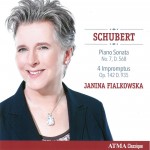 Janina Fialkowska’s new recording of Schubert – Piano Sonata No.7; Four Impromptus (ATMA ACD2 2699) is an example of familiar repertoire rethought, reconsidered and reinvented. Nothing has been turned on its head nor has Schubert been over-examined for missed content. The genius of his ideas lies in both their lyric value and in the exquisite nature of his supporting accompaniments. What Fialkowska has done is to redraw the emotional map that guides her playing through Schubert’s straightforward material. She plays the Impromptu No.2 in A-flat Major Op.142 D935 as if it were something sacred. The opening idea is delivered in utter simplicity and the middle section rises to a speed and intensity not often heard. This pulls the work’s emotional poles further apart and gives greater impact to the quiet ending. The other three impromptus, too, are wonderfully recast.
Janina Fialkowska’s new recording of Schubert – Piano Sonata No.7; Four Impromptus (ATMA ACD2 2699) is an example of familiar repertoire rethought, reconsidered and reinvented. Nothing has been turned on its head nor has Schubert been over-examined for missed content. The genius of his ideas lies in both their lyric value and in the exquisite nature of his supporting accompaniments. What Fialkowska has done is to redraw the emotional map that guides her playing through Schubert’s straightforward material. She plays the Impromptu No.2 in A-flat Major Op.142 D935 as if it were something sacred. The opening idea is delivered in utter simplicity and the middle section rises to a speed and intensity not often heard. This pulls the work’s emotional poles further apart and gives greater impact to the quiet ending. The other three impromptus, too, are wonderfully recast.The Piano Sonata No.7 in E -flat Major Op.122 D568 benefits from a release of tempo strictures in the second and third movements. Fialkowska gives Schubert’s simple ideas an airy freedom that feels so completely right. She is, as ever, the mature interpreter we have come to admire.
Concert Note: On April 1 and 2 Janina Fialkowska performs Chopin’s Concerto in F Minor with the Kitchener-Waterloo Symphony at the Centre in the Square.
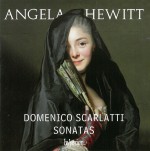 It’s always a pleasure to hear a new recording from Angela Hewitt, regardless of the repertoire. Early 2016 saw the release of Domenico Scarlatti – Sonatas (Hyperion CDA67613), her first project with this material and one which she hopes to pursue more. In her liner notes, Hewitt makes reference to the scholarly debate over whether the sonatas were originally intended to be paired or not. She has, nevertheless, chosen to devise her own groupings, to the sonatas’ best advantage.
It’s always a pleasure to hear a new recording from Angela Hewitt, regardless of the repertoire. Early 2016 saw the release of Domenico Scarlatti – Sonatas (Hyperion CDA67613), her first project with this material and one which she hopes to pursue more. In her liner notes, Hewitt makes reference to the scholarly debate over whether the sonatas were originally intended to be paired or not. She has, nevertheless, chosen to devise her own groupings, to the sonatas’ best advantage.
Playing her long-favoured Fazioli, Hewitt delivers a flawless technical performance with clarity never sacrificed to speed. Scarlatti’s sonata structures are simple enough to navigate and one might expect that in the course of 16 such works a certain amount of predictability would set in. But this never happens as Hewitt gives the main idea of each sonata a completely fresh approach. She also never misses a contrapuntal opportunity, and plenty abound throughout. Her ornaments and figures are perfect. She is also completely at ease using whatever technical advantage the modern piano offers to this older repertoire, whether dynamic or colouristic. The Sonata in G Minor Kk8 is an excellent example of this as is the Sonata in F Minor Kk69.
The final track is a bit of surprise as Hewitt’s choice of tempo is notably slower than most often heard. This turns the Sonata in E Major Kk380 into a far more thoughtful and even slightly melancholy utterance than we expect. We look forward to her next set of Scarlatti sonatas.
Concert Note: On April 13, 14 and 16, Angela Hewitt performs two piano concertos by Bach with the Toronto Symphony Orchestra. The program also features Symphony No.8 by Shostakovich, conducted by Peter Oundjian.
Review
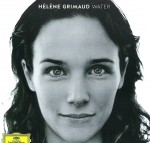 In her latest disc Hélène Grimaud – Water (Deutsche Grammophon CD 00289 479 3426), pianist Hélène Grimaud draws from the well of repertoire using water as its inspiration. Nearly every composer has written something depicting an aspect of water whether vast or minute. Her choices of works were guided by a live performance project incorporating art, music and architecture. Set in a New York armoury drill hall carefully flooded for added effect, the performance reflected her environmental concerns around the treatment of water as one of humanity’s most precious resources.
In her latest disc Hélène Grimaud – Water (Deutsche Grammophon CD 00289 479 3426), pianist Hélène Grimaud draws from the well of repertoire using water as its inspiration. Nearly every composer has written something depicting an aspect of water whether vast or minute. Her choices of works were guided by a live performance project incorporating art, music and architecture. Set in a New York armoury drill hall carefully flooded for added effect, the performance reflected her environmental concerns around the treatment of water as one of humanity’s most precious resources.
Grimaud immerses herself completely in the nature of the water theme. Aided by the cavernous acoustic of the armoury, she captures all the fluidness and sparkling images created by her chosen composers. Liszt’s Les Jeux d’eaux à la Villa d’Este is among the best tracks for its articulate shimmer in the upper registers. The Takemitsu Rain Tree Sketch II is beautiful for its deeply haunting reserve and Fauré’s Barcarolle flows with unbound rhythmic freedom throughout. The best track is, however, Debussy’s La Cathédrale engloutie. Here Grimaud evokes an architectural grandness and solemnity so appropriate to the composer’s image for the piece.
The recording produced at the art installation is combined with seven electro-acoustic compositions by Nitin Sawhney that act as transitions between her eight piano pieces. The contemporary works serve effectively as transitions between the traditional repertoire and are, in fact, titled as such, Transition 1, 2, etc. They alternate seamlessly from one track to the next and make for a truly fascinating listen.
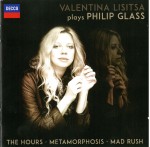 It’s hard to imagine the mindset that a pianist must adopt to undertake an extensive project like Valentina Lisitsa plays Philip Glass (Decca 478 8079 DH2). This two-disc set contains nine selections from The Hours and other films like Mishima and The Truman Show. Lisitsa also plays the Metamorphosis I-V and the half-hour long How Now.
It’s hard to imagine the mindset that a pianist must adopt to undertake an extensive project like Valentina Lisitsa plays Philip Glass (Decca 478 8079 DH2). This two-disc set contains nine selections from The Hours and other films like Mishima and The Truman Show. Lisitsa also plays the Metamorphosis I-V and the half-hour long How Now.
Conventionally, one imagines a performer mapping out thematic structure and development, and attending to such concerns as articulation and phrasing. But in Glass’ world these things can have far less significance and a performer may look elsewhere to prepare.
Glass describes himself as a composer of “music with repeating structures” and it’s this device that predominates throughout the repertoire in this set. Lisitsa takes an approach that respects the important patterns of Glass’ work but leaves her enough expressive room to use speed and dynamics to shape the music. This is most evident in How Now and Wichita Vortex Sutra. The experience of playing this often hypnotic music is challenging. Lisitsa reaches successfully for the other worldliness of Glass’ minimalist voice. She never loses herself in it because she understands that the immersive experience of Glass’ music is best reserved for the listener.
Concert Note: Valentina Lisitsa performs at Koerner Hall at 3pm on April 10. The program will include Scriabin, Tchaikovsky and Rachmaninov.
Review
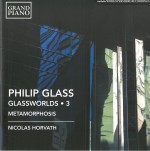 Young pianist Nicolas Horvath has a very impressive reputation as a Liszt interpreter. It’s no surprise then, that his approach to Glass in Philip Glass – Glassworlds 3; Metamorphosis (Grand Piano GP691) is strikingly different. His own liner notes to this recording reveal his inclination toward analytical detail. At the keyboard he extracts thematic material from the rotating structures that Glass sets spinning like so many Buddhist prayer wheels. In doing so he compels the listener to experience the music more melodically than its hypnotic patterns might otherwise allow. This sets his performance of the Metamorphosis I-V apart from most others. The melodic imperative that seems to drive Horvath’s interpretation of Glass’ music is even more powerful in Einstein on the Beach and the Piano Sonatina No.2 (1959). There’s even a hint of programmatic interpretation in the piano version of The Olympian – Lighting of the Torch and Closing.
Young pianist Nicolas Horvath has a very impressive reputation as a Liszt interpreter. It’s no surprise then, that his approach to Glass in Philip Glass – Glassworlds 3; Metamorphosis (Grand Piano GP691) is strikingly different. His own liner notes to this recording reveal his inclination toward analytical detail. At the keyboard he extracts thematic material from the rotating structures that Glass sets spinning like so many Buddhist prayer wheels. In doing so he compels the listener to experience the music more melodically than its hypnotic patterns might otherwise allow. This sets his performance of the Metamorphosis I-V apart from most others. The melodic imperative that seems to drive Horvath’s interpretation of Glass’ music is even more powerful in Einstein on the Beach and the Piano Sonatina No.2 (1959). There’s even a hint of programmatic interpretation in the piano version of The Olympian – Lighting of the Torch and Closing.
By contrast, however, Horvath completely abandons all classical/romantic sensibilities in Two Pages (1968), choosing instead to favour the dominant mechanical nature of the repeating figures, leaving only Glass’ subtle changes to play with the listener’s mind. This kind of versatility makes Horvath a compelling interpreter and presents the repertoire in a deeply engaging and listenable way. This disc is the third volume in his Glassworlds series.
Review
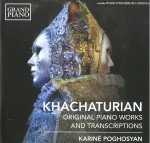 Kariné Poghosyan is an Armenian-American pianist teaching at the Manhattan School of Music. With a scholarly thesis on the piano music of Aram Khachaturian to her credit, her latest recording Khachaturian – Original Piano Works and Transcriptions (Grand Piano GP673) demonstrates the affinity she has for this composer’s work.
Kariné Poghosyan is an Armenian-American pianist teaching at the Manhattan School of Music. With a scholarly thesis on the piano music of Aram Khachaturian to her credit, her latest recording Khachaturian – Original Piano Works and Transcriptions (Grand Piano GP673) demonstrates the affinity she has for this composer’s work.
The disc includes a new piano transcription of the Masquerade Suite with its familiar Waltz, and the Suite No.2 from the ballet Spartacus, in a new arrangement by Matthew Cameron. Both performances are world premieres but the latter is impressive for the way it presents the ballet’s well-known main theme, particularly in its wide, sweeping orchestral gestures.
Also on the disc is Poem, a very early and somewhat troubled work that Poghosyan performs with conviction, finding great serenity in the quieter sections to balance the work’s darker passages.
The recording’s finest piece is, however, the Piano Sonata from 1961, one of Khachaturian’s few formal efforts in larger forms. The opening movement is breathtaking for its relentless motion that only has a brief respite midway through. Poghosyan plays this brilliantly and brings it to an edge-of-your-seat close. The second movement is remarkable for its unfamiliar and sometimes experimental language. The final movement brings back the energy of the first but with more intensity. This must be an exhausting piece to perform live. It is excitement combined with mystery and Poghosyan plays it masterfully.
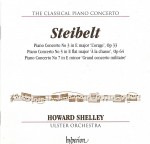 We tend to have set notions of the personalities that shaped the music of most historical periods. While the names of those who dominate obscure the lesser, we sometimes find, in the shadows, new material that helps us understand an age in a richer way. And so it is with the music of Daniel Steibelt and a new recording by Howard Shelley that presents three of his piano concertos in Stiebelt (Hyperion CDA68104).
We tend to have set notions of the personalities that shaped the music of most historical periods. While the names of those who dominate obscure the lesser, we sometimes find, in the shadows, new material that helps us understand an age in a richer way. And so it is with the music of Daniel Steibelt and a new recording by Howard Shelley that presents three of his piano concertos in Stiebelt (Hyperion CDA68104).
Born to German/French parents, Steibelt was a contemporary of Mozart and Beethoven. He built his career as a pianist and composer in France and England at the turn of the 19th century. He is reported to have famously challenged Beethoven to a piano duel and forever lived with the humiliation of that ill-conceived contest. Steibelt’s music shows his remarkable keyboard facility with extended runs and complex ornamentation. Although his work shows him to have been a fine tunesmith, he is judged to have been much less competent at thematic development.
Pianist and conductor Howard Shelley performs the Piano Concertos Nos. 3, 5 and 7 with the Ulster Orchestra. Shelley’s playing is graceful and delivers the full value of Steibelt’s decorative tunes, many of them finely crafted and memorable, especially the Scottish folk melodies in the slow movements. The orchestra is superbly balanced with the piano, and while conducted from the keyboard, their performance is unerringly intimate with the soloist. The recording is a welcome document of a deserving, if lesser known, composer.
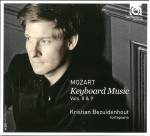 Lauded by critics as the finest fortepiano performer of our time, Kristian Bezuidenhout has issued another installment in his ambitious Mozart recording project, Mozart Keyboard Music Vols. 8 & 9 (Harmonia Mundi HMU 907532.33). Bezuidenhout plays a fortepiano built in 2009, copied from a Viennese Walter & Sohn of 1805. The instrument is tuned to A 430 and set in unequal temperament. This has the effect of reducing the instrument’s resonance in keys not part of C Major’s harmonic overtone series, like D and F. This is hardly noticeable since the fortepiano has, overall, characteristically less resonance than our modern pianos.
Lauded by critics as the finest fortepiano performer of our time, Kristian Bezuidenhout has issued another installment in his ambitious Mozart recording project, Mozart Keyboard Music Vols. 8 & 9 (Harmonia Mundi HMU 907532.33). Bezuidenhout plays a fortepiano built in 2009, copied from a Viennese Walter & Sohn of 1805. The instrument is tuned to A 430 and set in unequal temperament. This has the effect of reducing the instrument’s resonance in keys not part of C Major’s harmonic overtone series, like D and F. This is hardly noticeable since the fortepiano has, overall, characteristically less resonance than our modern pianos.
These two volumes are well programmed with plenty of contrasting pieces that make listening through their entirety highly enjoyable. The familiar Sonata in C Major K545 opens the set and is striking for the degree of clarity and articulation Bezuidenhout is able to express at this keyboard. He plays the Gigue in G Major K574 with an incisive angularity applied to both the rhythmic patterns and the intervallic leaps that must have delighted Mozart in writing them. He also includes three sets of variations and a couple of fragments completed by Mozart scholar Robert Levin.
Bezuidenhout is a dynamic player not shy about digging into the instrument forcefully to generate a fortissimo. He’s equally adept at key touch so light that some notes seem to disappear on first hearing. A quick replay confirms their presence but only at the softest levels.
The two-disc set contains selected works from 1774 to 1790 and, like the rest of the series, is not chronological.



